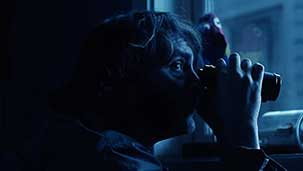What more to expect from a film adapted from one of your novels than to be utterly confused, utterly compelled? Your work sometimes feels like one big practical joke played on the reader - knotted allusions that may or may not connect, may or may not loop back on themselves, may or may not be allusions at all. And one might see Paul Thomas Anderson’s film adaptation of Inherent Vice as a cruel trick perpetrated on the audience. And it might be. But if you’re in on the joke, if you’re willing to laugh at yourself, it’s a satisfying – and sometimes hilarious – experience.
Inherent Vice was your take on the hard-boiled Raymond Chandler mode of detective story. The film version, to greater and lesser degrees, is Anderson’s take on Altman’s The Long Goodbye (which, of course, was based on a Chandler novel). It’s the sort of fantasy drafting that film geeks propose over pints of craft beer. The Los Angeles described in your novel is the same peripheral Los Angeles that Anderson has been plundering for inspiration since Boogie Nights and Magnolia. It’s a drowsy, yellowed, desperate L.A full of drifters, druggies, and losers, far from the mansions of Beverly Hills, the hip night spots, and the movie premieres.
When Inherent Vice was published in 2009, it was greeted with much respect but little enthusiasm. Sam Anderson ripped the novel in New York Magazine, writing that you were “clearly having a postmodern blast warping the building blocks of detective fiction—causation, probability, significance, suspense. But it’s not quite so much fun for the reader. It’s hard to stay invested in a plot in which everything is so casually interconnected.” He implies that there’s nothing at stake in your narrative. Therefore, is there nothing at stake in P.T. Anderson’s interpretation of it? I’ll admit, yes, there’s something static about his cinematic interpretation of Inherent Vice. But while the overarching narrative sometimes feels a bit inert, the individual scenes have their own velocity. As a series of comedy sketches, they are divine. The film is aligned with the approach you’ve taken throughout your career of dismantling the traditional structure of the novel: the parts are the whole and the sum doesn’t matter.
To make whatever sense there is to be made of this, Anderson takes a minor character from the book and makes her your stand-in: Sortilege appears, in the first frames of the film, almost as a ghost, double-exposed over the beachside landscape. As she reappears throughout the film, she communicates exclusively with Doc and is never acknowledged by any other characters onscreen. That enigmatic Pynchonian presence is transferred to her. She has the voice of a precocious little girl playing cool, a pre-teen reading aloud from one of your novels found on her parents bookcase, and her narration provides that aloof, absurdist, self-referential editorializing that your prose is known for.
Both yours and Anderson’s reputations are rooted in your technical proficiency (Anderson’s complex tracking shots, your complex plots), and your care with composition. Anderson shot this film in 35mm – just like he did with his last film, The Master – and director of photography Robert Elswit should win some kind of award just for the way he shoots Eric Roberts’ face in the last act of the film. It’s a moment that reinforces that old actor’s adage that the one person on set you want to be friends with is the cinematographer. Roberts has about four minutes of screen time and has never been more compelling. Everything is dark, muddled in shadows. Even when Joaquin Phoenix, as paranoid private dick Larry “Doc” Sportello, is lounging around his sunny beachside pad, his face is overcast, only dimly visible. It’s perpetually evening in this film. Even in the middle of the afternoon.
You also share an infantile sense of humor. The movie, just like the book, is at its heart a comedy. It’s full of spit takes, double-takes, and startled yelps. There are some amazing bits of physical comedy: Josh Brolin sucking on frozen bananas, Martin Short tripping about with his pants around his ankles. But no one is better than Phoenix, who channels Peter Sellers: he’s a stoner Clouseau, tiptoeing through bedrooms, getting knocked over by cops while crossing the street, getting cracked on the head with a blackjack, half-turning, raising a finger as if to ask a question, and collapsing—all in one fluid movement. There’s nothing objectively funny about an angry cop ordering pancakes in Japanese, but I haven’t laughed harder in a theater all year (with one important exception).
Inherent Vice occurs at the nadir of the counterculture the same way Boogie Nights takes place at the death of the porn-on-film era (damn you, Floyd Gondoli!). This perhaps explains the current of melancholy that runs throughout. The good times are ending, flower power proven finite. Katherine Waterson (who plays the dame who kicks the whole thing off, in classic Spillane style) is the vessel for this sadness and fatigue. She’s the real star of the film. In her performance is all the earnestness that your body of work consciously despises, which makes Anderson’s vision of your scummy 70s underworld of cults and conspiracies several degrees more human.
Yeah, none of it matters. Plot threads dangle, important characters disappear, knots remain unknotted. But Anderson gives it all just enough warmth to counteract the coldness of the joke that’s being played. And for that I’m sure you’re grateful.
Sincerely,

Jared







